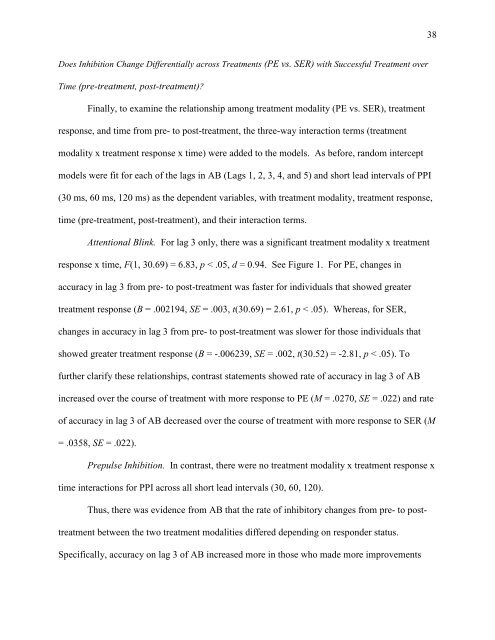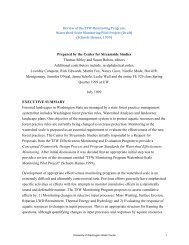Copyright 2012 Aileen M. Echiverri-Cohen - University of Washington
Copyright 2012 Aileen M. Echiverri-Cohen - University of Washington
Copyright 2012 Aileen M. Echiverri-Cohen - University of Washington
Create successful ePaper yourself
Turn your PDF publications into a flip-book with our unique Google optimized e-Paper software.
Does Inhibition Change Differentially across Treatments (PE vs. SER) with Successful Treatment over<br />
Time (pre-treatment, post-treatment)?<br />
Finally, to examine the relationship among treatment modality (PE vs. SER), treatment<br />
response, and time from pre- to post-treatment, the three-way interaction terms (treatment<br />
modality x treatment response x time) were added to the models. As before, random intercept<br />
models were fit for each <strong>of</strong> the lags in AB (Lags 1, 2, 3, 4, and 5) and short lead intervals <strong>of</strong> PPI<br />
(30 ms, 60 ms, 120 ms) as the dependent variables, with treatment modality, treatment response,<br />
time (pre-treatment, post-treatment), and their interaction terms.<br />
Attentional Blink. For lag 3 only, there was a significant treatment modality x treatment<br />
response x time, F(1, 30.69) = 6.83, p < .05, d = 0.94. See Figure 1. For PE, changes in<br />
accuracy in lag 3 from pre- to post-treatment was faster for individuals that showed greater<br />
treatment response (B = .002194, SE = .003, t(30.69) = 2.61, p < .05). Whereas, for SER,<br />
changes in accuracy in lag 3 from pre- to post-treatment was slower for those individuals that<br />
showed greater treatment response (B = -.006239, SE = .002, t(30.52) = -2.81, p < .05). To<br />
further clarify these relationships, contrast statements showed rate <strong>of</strong> accuracy in lag 3 <strong>of</strong> AB<br />
increased over the course <strong>of</strong> treatment with more response to PE (M = .0270, SE = .022) and rate<br />
<strong>of</strong> accuracy in lag 3 <strong>of</strong> AB decreased over the course <strong>of</strong> treatment with more response to SER (M<br />
= .0358, SE = .022).<br />
Prepulse Inhibition. In contrast, there were no treatment modality x treatment response x<br />
time interactions for PPI across all short lead intervals (30, 60, 120).<br />
Thus, there was evidence from AB that the rate <strong>of</strong> inhibitory changes from pre- to post-<br />
treatment between the two treatment modalities differed depending on responder status.<br />
Specifically, accuracy on lag 3 <strong>of</strong> AB increased more in those who made more improvements<br />
38
















